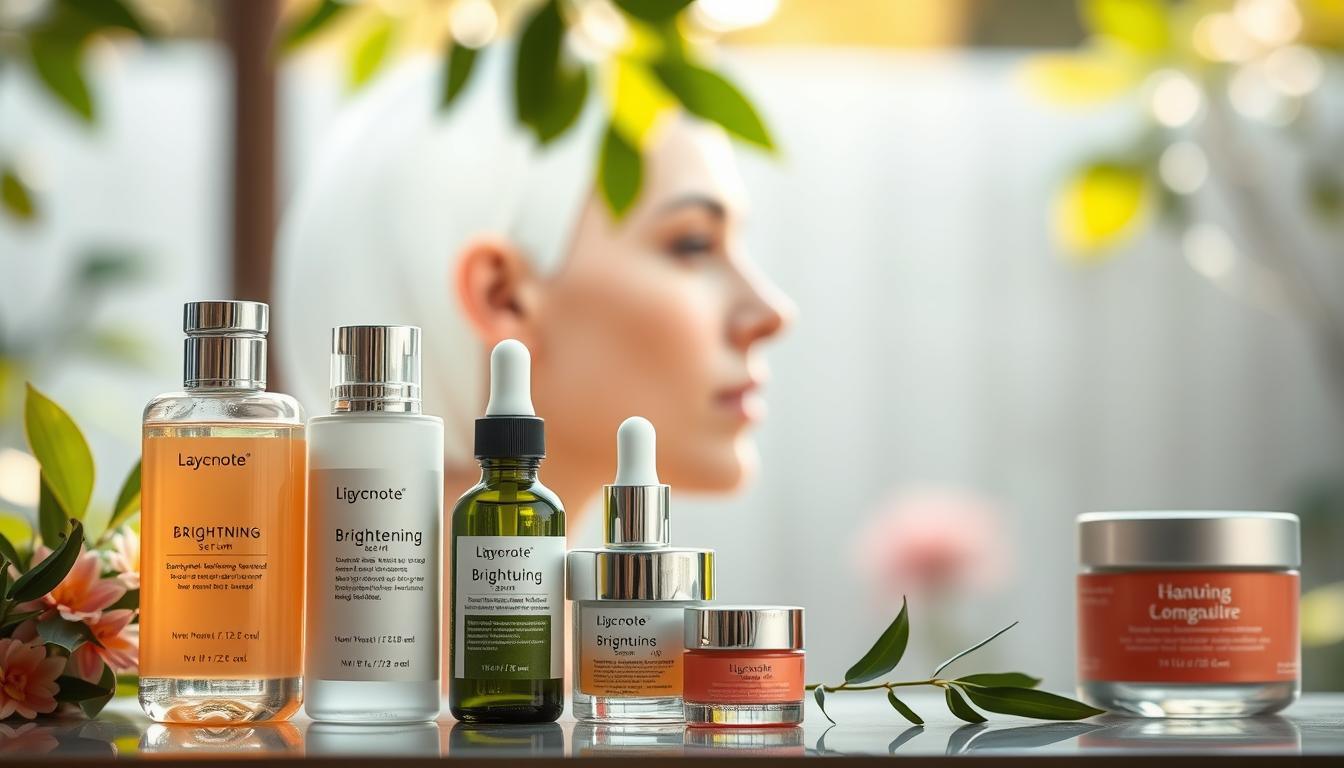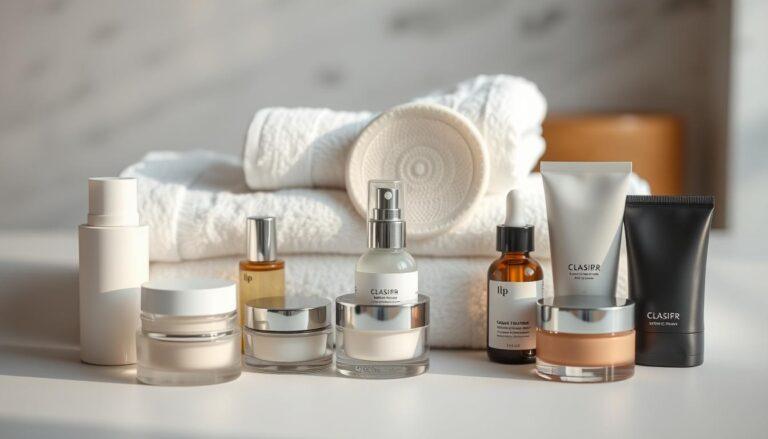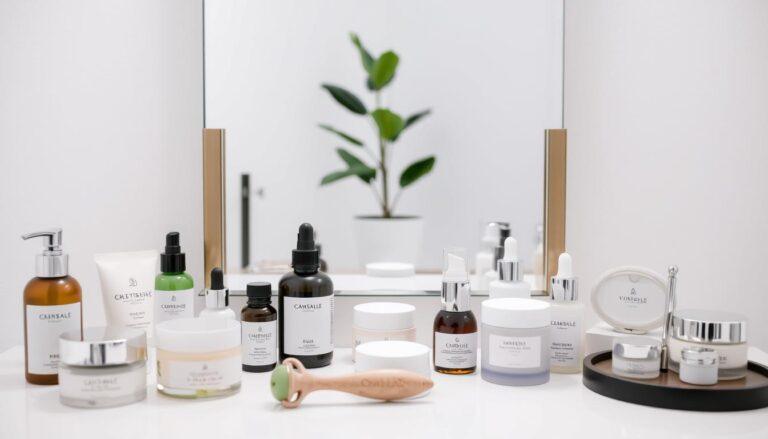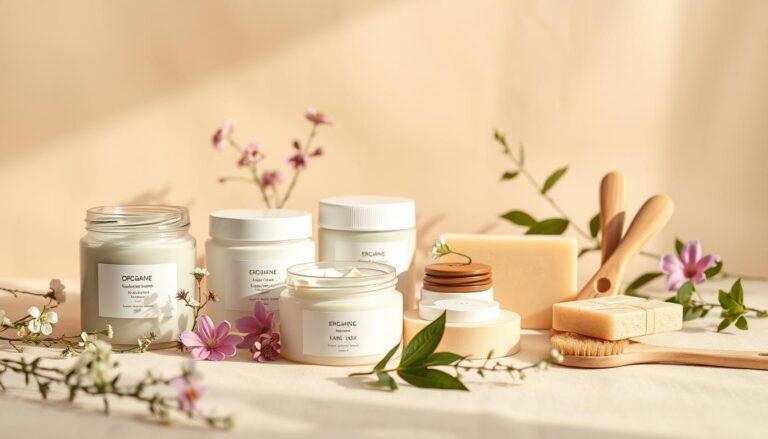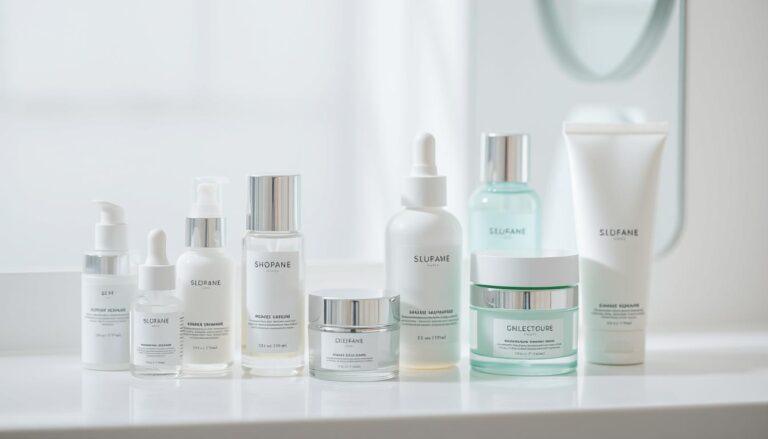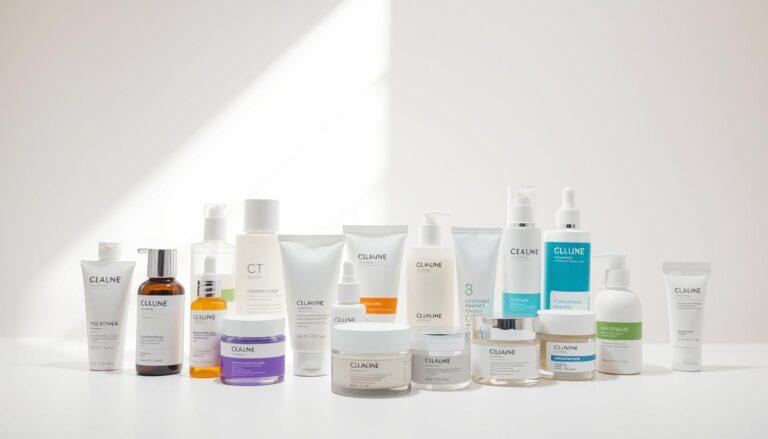Hyperpigmentation Skin Care Routine: Step-by-Step Guide to Even Skin Tone
Dealing with uneven tone on my face has been a journey. Like many, I’ve struggled with dark spots and patches that made me feel less confident. Over time, I learned that understanding the root cause—like excess melanin—was the first step toward achieving a more radiant look.
Everyone’s experience is unique, and what works for one person might not work for another. That’s why I created this guide. It’s designed to help you navigate both over-the-counter and professional options, tailored to your specific needs.
In this step-by-step guide, we’ll explore practical solutions, from facial acids to retinoids, to help you achieve a more even tone. Whether you’re just starting or looking to refine your approach, this guide is here to inspire and empower you.
Key Takeaways
- Hyperpigmentation is caused by excess melanin, leading to dark spots and uneven tone.
- Everyone’s needs are unique, and solutions should be tailored accordingly.
- This guide covers both over-the-counter and professional treatment options.
- Step-by-step instructions make it easy to follow and implement.
- Consistency is key to achieving and maintaining radiant results.
Understanding Hyperpigmentation
Understanding why certain areas of my face appear darker has been eye-opening. It’s not just about appearance—it’s about the science behind it. Hyperpigmentation occurs when there’s an overproduction of melanin, the pigment responsible for our complexion. This can lead to dark patches, spots, or uneven tone.
What is Hyperpigmentation?
Hyperpigmentation is a common condition where certain areas of the skin become darker than the surrounding areas. This happens when melanin production increases due to various triggers. Examples include age spots, melasma, and post-inflammatory changes caused by acne or injuries.
Causes and Contributing Factors
Several factors can lead to this condition. Sun exposure is a major culprit, as UV rays stimulate melanin production. Hormonal changes, like those during pregnancy, can also trigger melasma. Additionally, skin injuries or inflammation from acne can result in post-inflammatory hyperpigmentation.
Dermatologists emphasize that these causes are common and treatable. For instance, using sunscreen daily can prevent sun-induced pigmentation. Understanding these factors is the first step toward finding the right solution for your unique needs.
The Role of Sun Exposure and Skin Damage
Protecting my complexion from the sun’s harmful effects has been a game-changer. I’ve learned that UV rays are one of the biggest contributors to uneven tone and dark spots. Even brief exposure can lead to long-term damage, making sun protection a must.
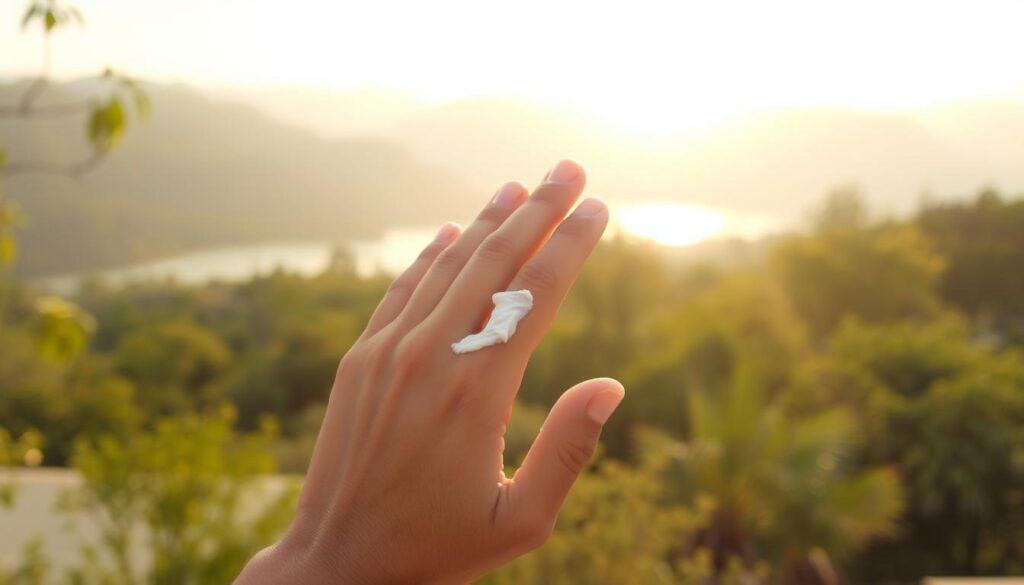
Importance of Sun Protection
UV rays, especially UVA and UVB, penetrate the skin and trigger melanin production. This not only worsens existing dark spots but also creates new ones. Daily sunscreen use is the simplest way to prevent this damage.
Even indoors, UV rays can reach through windows, so applying SPF every morning is essential. I’ve found that consistency is key to maintaining a radiant look. For more personalized advice, reach out to experts who can guide you.
Selecting the Right SPF
Choosing the right SPF can feel overwhelming, but it doesn’t have to be. Here’s what I’ve learned:
- SPF 30 or higher is ideal for daily use.
- Look for broad-spectrum formulas to protect against both UVA and UVB rays.
- Physical sunscreens with zinc oxide or titanium dioxide are great for sensitive skin.
Reapplying every two hours, especially when outdoors, ensures maximum protection. Pairing sunscreen with protective clothing, like hats and sunglasses, adds an extra layer of defense.
Key Ingredients in Treating Dark Spots
Exploring the science behind key ingredients has transformed my approach to tackling dark spots. I’ve learned that certain actives can make a noticeable difference in reducing uneven tone. Let’s dive into the most effective ingredients and how they work.
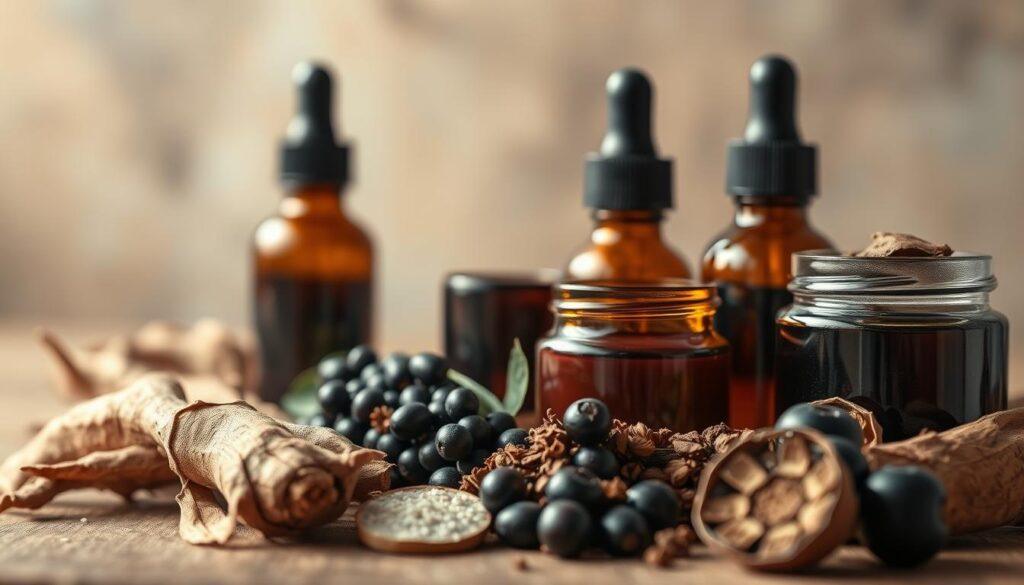
Effective Actives: Acids, Retinoids, and Vitamin C
Acids like glycolic and salicylic are powerful exfoliants. They remove dead cells, revealing brighter layers underneath. Retinoids, derived from vitamin A, penetrate deeper to boost cell turnover. This helps fade dark spots over time.
Vitamin C is another superstar. It brightens the complexion and protects against environmental damage. Dermatologists often recommend using these actives in serums for better absorption.
Botanical Extracts and Natural Brighteners
For sensitive areas, botanical extracts are a gentler option. Ingredients like licorice root and niacinamide naturally brighten without irritation. They also help even out tone and reduce redness.
Here’s a quick comparison of these ingredients:
| Ingredient | Benefits | Best For |
|---|---|---|
| Glycolic Acid | Exfoliates, brightens | Mild discoloration |
| Retinol | Boosts cell turnover | Deep spots |
| Vitamin C | Brightens, protects | Overall tone |
| Licorice Extract | Gentle brightening | Sensitive skin |
Incorporating these ingredients into your routine can yield impressive results. Start with a product that combines multiple actives for a balanced approach. Always patch-test new products to ensure compatibility.
Steps to a Hyperpigmentation Skin Care Routine
Building a structured approach to address uneven tone has been transformative for me. By following a clear, step-by-step process, I’ve seen gradual improvements in my complexion. Here’s how you can create your personalized routine for better results.
Start with a gentle cleanser to remove dirt and impurities. This prepares your face for the next steps. Exfoliate 2-3 times a week to slough off dead cells and allow active ingredients to penetrate deeper.
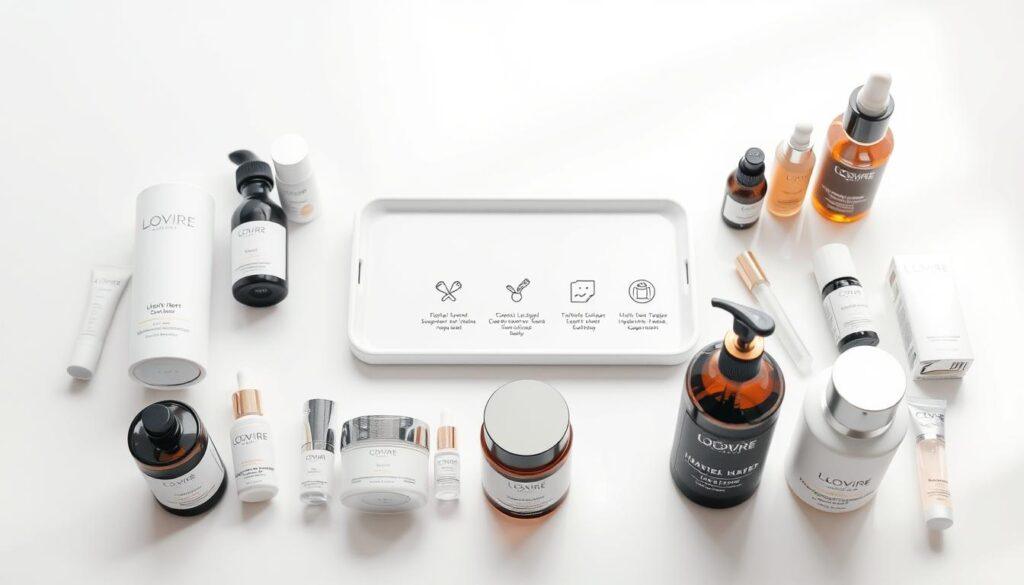
Next, apply a targeted treatment like vitamin C or retinoids. These ingredients brighten and reduce discoloration over time. Layer a hydrating moisturizer to keep your face nourished and balanced.
Finally, don’t forget sunscreen. Daily SPF protects against UV rays, preventing further damage. Reapply every two hours when outdoors for maximum effectiveness.
Consistency is key. Stick to your routine and adjust based on how your skin responds. Patience is essential, as results can take 8-12 weeks to show. With the right approach, you’ll see a more even and radiant look.
Morning Skincare Routine for a Radiant Complexion
Starting my day with a focused morning routine has made a noticeable difference in my complexion. It’s not just about looking good—it’s about feeling confident and ready to take on the day. Here’s how I structure my mornings for a glowing look.
Cleansing and Exfoliation Techniques
I begin with a gentle cleanser to remove impurities and prep my face for the next steps. Cleansing is crucial because it ensures that active ingredients can penetrate effectively. For exfoliation, I use a chemical exfoliant with glycolic acid twice a week. This helps remove dead cells and promotes cell renewal.
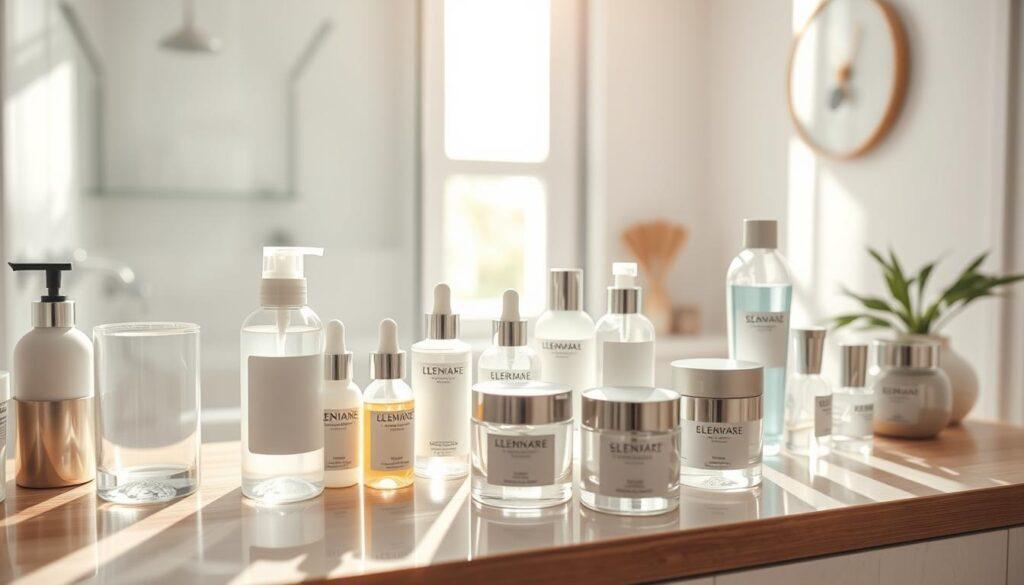
Exfoliation is essential for maintaining a smooth texture. As one dermatologist put it,
“Regular exfoliation enhances product absorption and effectiveness, making it a cornerstone of any routine.”
I’ve found this to be true in my experience.
Serum Application and Sunscreen Essentials
After cleansing, I apply a vitamin C serum. This brightens my complexion and reduces the appearance of dark spots. Vitamin C is a powerhouse ingredient that also protects against environmental damage. I follow this with a hydrating moisturizer to keep my face balanced.
The final step is sunscreen. I use a broad-spectrum SPF 50+ to shield my face from harmful UV rays. Sunscreen is non-negotiable—it prevents further damage and locks in the benefits of my morning routine. Here’s a quick comparison of my go-to products:
| Product | Key Ingredient | Benefit |
|---|---|---|
| Gentle Cleanser | Hyaluronic Acid | Hydrates and cleanses |
| Glycolic Acid Exfoliant | Glycolic Acid | Promotes cell renewal |
| Vitamin C Serum | Vitamin C | Brightens and protects |
| Broad-Spectrum SPF | Zinc Oxide | Shields against UV rays |
By following this routine, I’ve seen gradual improvements in my complexion. Consistency is key, and with the right products, you can achieve a radiant look too.
Evening Routine: Repair and Renewal
Nighttime has become my favorite part of the day because it’s when my face gets the chance to heal and renew itself. This is when I focus on products that support repair and renewal overnight. A well-structured evening routine can make a significant difference in addressing uneven tone and boosting collagen production.
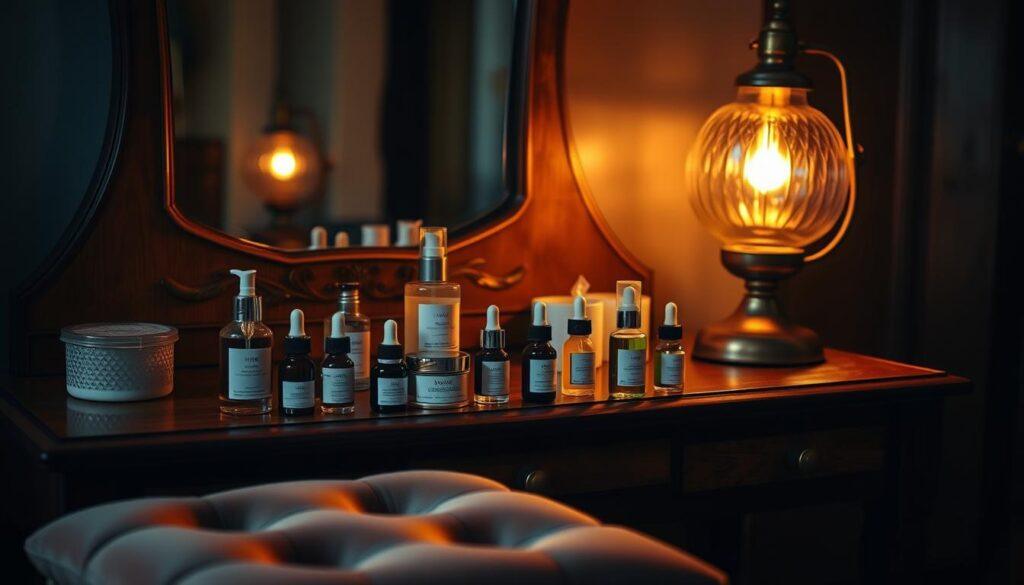
Nighttime Treatments and Moisturizing Strategies
I start my evening routine with a gentle cleanser to remove impurities and prepare my face for treatment. Next, I apply a retinol serum. Retinol is a game-changer—it accelerates cell turnover and helps fade dark spots over time. I use it three times a week to avoid irritation while still reaping its benefits.
After the serum, I layer on a rich moisturizing cream. This step is crucial for hydration and locking in the active ingredients. I’ve found that pairing retinol with a nourishing cream minimizes dryness and keeps my face balanced.
Here’s a quick comparison of my go-to nighttime products:
| Product | Key Ingredient | Benefit |
|---|---|---|
| Retinol Serum | Retinol | Boosts cell turnover |
| Nourishing Cream | Ceramides | Hydrates and repairs |
| Gentle Cleanser | Hyaluronic Acid | Removes impurities |
One tip I’ve learned is to avoid overusing active ingredients. Transitioning from daytime to nighttime products requires balance. For example, I alternate retinol with gentler treatments like niacinamide to prevent irritation.
Finally, I ensure my pillowcases are washed weekly. This simple habit reduces the risk of breakouts and keeps my face fresh. By following this routine, I’ve noticed smoother, more even tone over time. Consistency is key, and with patience, you’ll see results too.
Targeted Treatments for Persistent Dark Spots
Finding solutions for stubborn dark spots has been a learning experience. While daily routines help, some spots require more advanced approaches. I’ve explored in-office and at-home procedures to tackle these persistent issues. Here’s what I’ve learned about effective treatments.
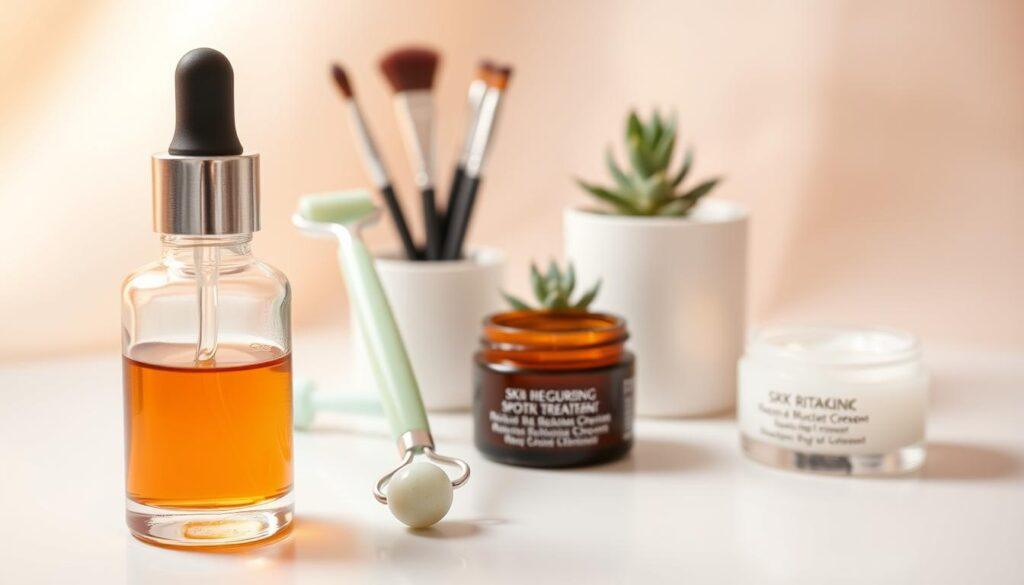
Chemical Peels: A Quick Refresh
Chemical peels are a popular option for addressing discoloration. They work by removing the top layer of cells, revealing brighter layers underneath. I’ve found that peels can improve texture and reduce the appearance of dark spots over time.
However, they’re not for everyone. Those with sensitive areas may experience redness or irritation. It’s best to consult a professional to determine the right peel for your needs.
Laser Resurfacing: Precision and Results
Laser treatments target deeper layers, making them ideal for stubborn spots. They use focused light to break down excess pigment, promoting even tone. I’ve seen impressive results with this method, especially for post-inflammatory hyperpigmentation caused by acne.
Keep in mind, laser resurfacing requires downtime. Your face may feel tender or swollen for a few days. Always follow post-treatment care instructions for the best outcome.
Microdermabrasion: Gentle Exfoliation
For a less invasive option, microdermabrasion is a great choice. It gently exfoliates the surface, reducing the appearance of flat spots. I’ve used this treatment to maintain a smooth texture and prevent new spots from forming.
While it’s gentler than peels or lasers, multiple sessions are often needed for noticeable results. Consistency is key to seeing improvements.
| Treatment | Benefits | Considerations |
|---|---|---|
| Chemical Peels | Brightens, improves texture | May irritate sensitive skin |
| Laser Resurfacing | Targets deep spots, precise | Requires downtime |
| Microdermabrasion | Gentle, no downtime | Multiple sessions needed |
When choosing a treatment, consider your skin’s sensitivity and the severity of your spots. For persistent issues, professional guidance can make all the difference. With the right approach, even the most stubborn spots can fade over time.
At-Home vs. In-Office Procedures
Deciding between at-home and professional treatments has been a pivotal part of my journey. Both approaches have their merits, but understanding when to use each can make all the difference. Here’s a breakdown of their benefits, limitations, and how to choose what’s best for your needs.
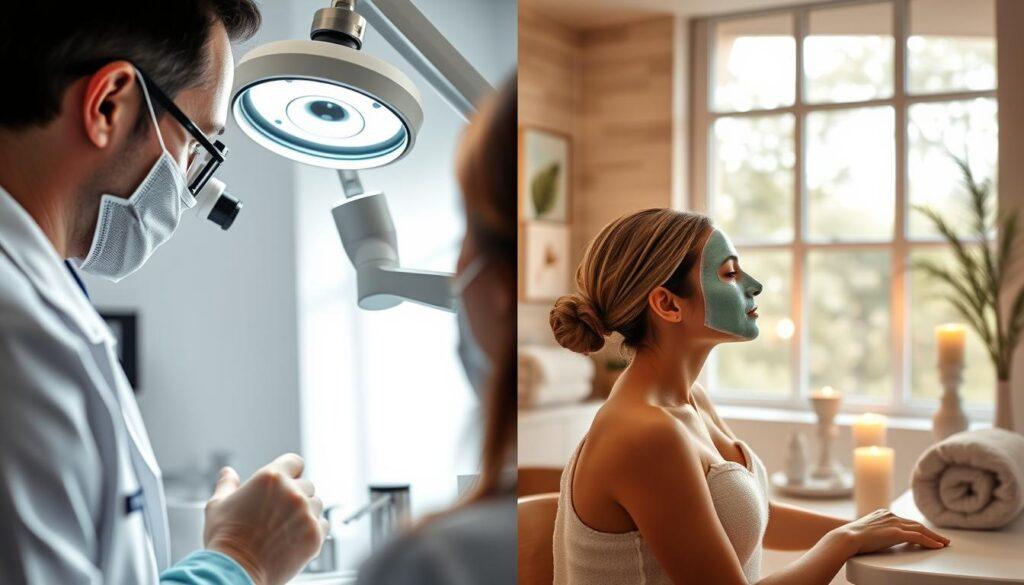
Comparing Safety and Efficacy
At-home treatments are convenient and often more affordable. Products like retinoids and vitamin C serums can yield impressive results over time. For example, retinoids boost skin cell turnover, helping fade dark spots in 4-6 weeks. However, consistency is key, and full benefits may take months.
In-office procedures, on the other hand, offer faster and more dramatic results. Treatments like chemical peels and laser resurfacing target deeper layers, addressing stubborn spots effectively. A dermatologist can tailor these treatments to your specific type of concern, ensuring safety and efficacy.
“Professional treatments often provide quicker results, but they require careful consideration and aftercare,” says a board-certified dermatologist.
When to Consult a Dermatologist
While many at-home products are effective, some concerns require professional expertise. If you have darker skin, certain treatments like lasers or peels can carry higher risks of irritation or discoloration. Consulting a dermatologist ensures you choose the safest and most effective approach.
Here’s a quick comparison to help you decide:
| Approach | Benefits | Limitations |
|---|---|---|
| At-Home | Affordable, convenient | Results take time |
| In-Office | Faster, more precise | Higher cost, downtime |
Understanding your skin cell behavior and type is crucial. For instance, darker skin may respond better to gentler treatments like microdermabrasion or specific ingredients like niacinamide. Always patch-test new products and seek professional advice for persistent concerns.
Ultimately, combining at-home care with occasional professional treatments can yield the best result. Whether you’re tackling mild discoloration or stubborn spots, the right approach depends on your unique needs and goals.
Exploring Advanced Therapies and LED Treatments
Exploring advanced therapies has opened my eyes to new possibilities for achieving a more even complexion. One of the most innovative approaches I’ve discovered is LED therapy. This non-invasive treatment uses specific wavelengths of light to target various concerns, from inflammation to discoloration.
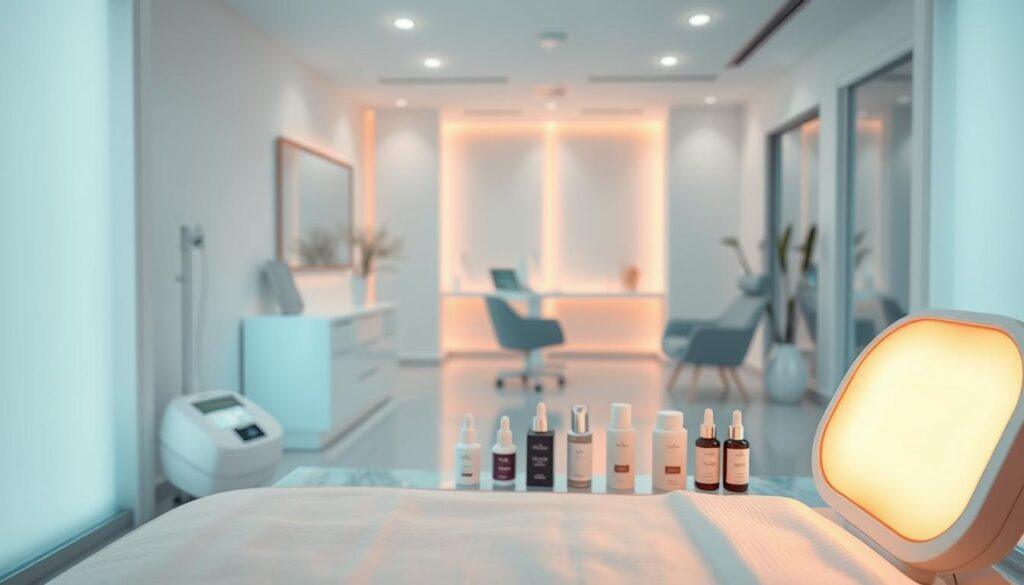
Benefits of Red LED and Light Therapy
Red LED therapy has become a favorite in my routine. It operates at wavelengths between 620 to 750 nanometers, which penetrate deep into the skin. This stimulates collagen production and reduces inflammation, making it ideal for improving texture and tone.
What I love most about red light therapy is its minimal side effects. Unlike harsh treatments, it’s gentle and suitable for all skin types. Regular sessions can boost cellular energy, helping to fade dark spots and promote a radiant look.
“Red light therapy is a game-changer for those seeking a non-invasive way to rejuvenate their complexion,” says a skincare expert.
When to Consider Professional Laser Options
While LED therapy is effective, some concerns may require more advanced solutions. Professional laser treatments target deeper layers, offering faster and more dramatic results. They’re particularly useful for stubborn spots that don’t respond to at-home methods.
However, laser treatments come with downtime and potential risks, especially for sensitive skin. Consulting a dermatologist ensures you choose the safest and most effective approach for your needs.
Here’s a quick comparison of the two options:
| Treatment | Benefits | Considerations |
|---|---|---|
| Red LED Therapy | Non-invasive, boosts collagen | Results take time |
| Laser Treatment | Fast, precise | Downtime, higher cost |
Integrating light therapy into your routine is simple. Start with a serum or acid-based product to prep your skin, then use an LED device for 10-20 minutes, 3-5 times a week. Consistency is key to seeing improvements.
Whether you choose LED or laser, both approaches offer unique benefits. For persistent issues, professional guidance can make all the difference. With the right treatment, achieving a more even complexion is within reach.
Selecting Products That Suit My Skin Type
Navigating the world of skincare products has taught me the importance of tailored choices. What works for one person might not work for another, even if we share a similar skin tone. Understanding my skin type and its unique needs has been key to finding the right products.
When I first started, I didn’t pay much attention to labels. But over time, I learned that the ingredients list is a treasure trove of information. The first five ingredients usually make up 80% of the formula, so I focus on those to ensure compatibility with my skin type.
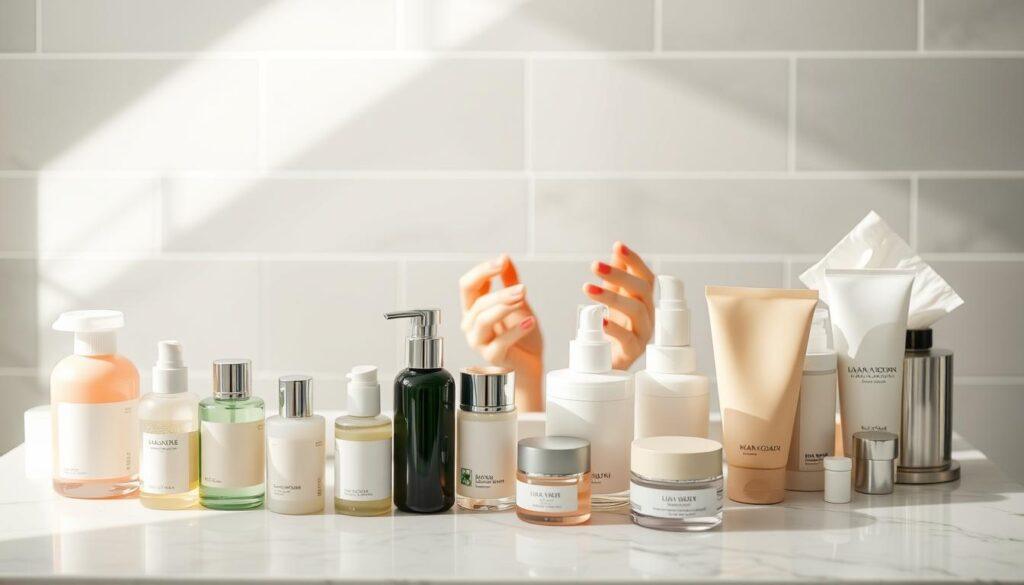
For example, if you have oily skin, look for ingredients like salicylic acid or benzoyl peroxide. These help control excess oil and prevent breakouts. On the other hand, dry skin benefits from hydrating ingredients like shea butter or lactic acid. Sensitive skin types should opt for gentle formulas with aloe vera or oatmeal.
Texture also plays a big role. I’ve found that lightweight serums work best for my combination skin, while richer creams are ideal for drier areas. It’s all about finding what feels comfortable and effective for your face.
“The right product can make all the difference, but it’s important to patch-test new items to avoid irritation,” advises a skincare expert.
Here’s a quick guide to help you choose:
| Skin Type | Recommended Ingredients |
|---|---|
| Oily | Salicylic acid, benzoyl peroxide |
| Dry | Shea butter, lactic acid |
| Sensitive | Aloe vera, oatmeal |
Remember, consistency is key. Stick to a routine for at least 4-6 weeks to see results. And always check expiration dates—most products last 6-12 months after opening.
By taking the time to understand my skin type and choosing products that suit it, I’ve seen a noticeable improvement in my complexion. It’s a process, but the results are worth it.
Customizing Your Routine with Expert Advice
Seeking expert advice has been a turning point in my journey to a healthier complexion. While over-the-counter products can help, consulting a dermatologist provided personalized guidance that made all the difference. Their expertise helped me tailor my routine to address specific concerns effectively.
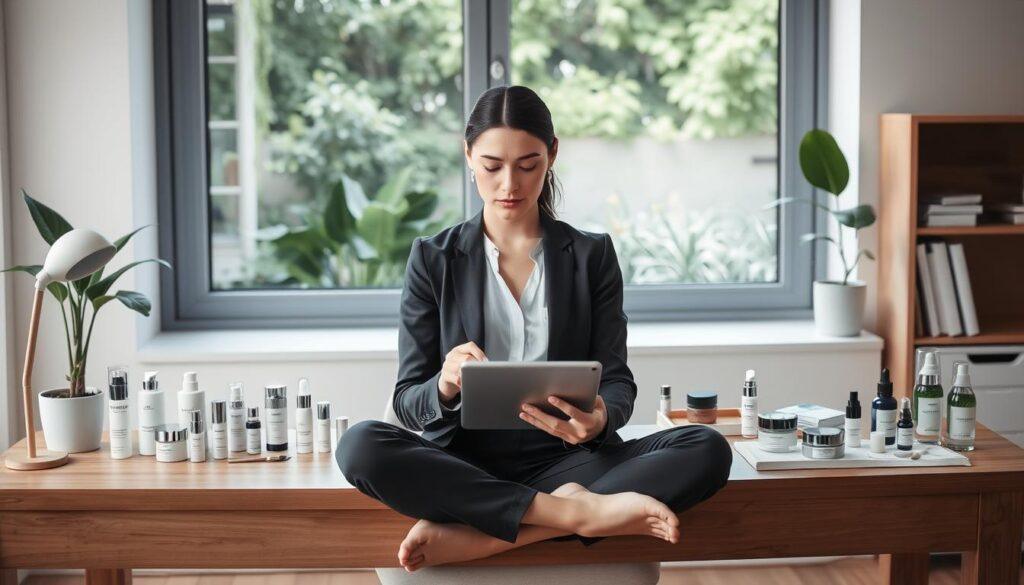
Consulting a Dermatologist for Personalized Guidance
During my first consultation, I learned that a dermatologist does more than diagnose issues—they create a customized plan. For example, they adjusted the frequency of my treatments and recommended specific ingredients based on my skin’s needs. This approach ensured my routine evolved as my complexion changed over time.
Here’s what I’ve learned about making the most of a consultation:
- Come prepared with a list of concerns and current products.
- Be honest about your habits, like sun exposure or stress levels.
- Ask questions about treatments and their expected results.
“Personalized advice from a professional ensures your routine is both safe and effective,” says a board-certified dermatologist.
Professional guidance also helped me avoid common mistakes, like overusing active ingredients. For instance, my dermatologist suggested alternating retinol with gentler options to prevent irritation. This balance kept my skin healthy while addressing persistent issues.
Remember, seeking help is a proactive step toward achieving clearer, more even tone. Whether you’re dealing with mild concerns or stubborn spots, a dermatologist can provide the tailored advice you need. With their support, you’ll feel confident in your routine and see lasting results.
Maintaining an Even Skin Tone Over Time
Achieving a balanced complexion has taught me the value of patience and persistence. It’s not just about quick fixes—it’s about building habits that support long-term results. Consistency is the cornerstone of maintaining an even skin tone, and it starts with simple, daily practices.

The Importance of Consistency and Sun Protection
One of the most crucial steps in my routine is applying sunscreen every day. UV rays are a leading cause of uneven tone, and skipping SPF can undo weeks of progress. I’ve learned that broad-spectrum formulas with SPF 30 or higher are essential for effective protection.
Beyond sunscreen, I focus on layering products correctly. Starting with a gentle cleanser, I follow up with targeted treatments like vitamin C or niacinamide. These ingredients brighten and protect, helping to maintain a radiant look over time.
“Daily sunscreen use is non-negotiable for anyone looking to preserve their complexion,” says a skincare expert.
Here are some strategies I’ve found helpful for tracking progress and adjusting routines:
- Take monthly photos to monitor changes in your skin tone.
- Keep a journal to note how your face reacts to new products.
- Adjust your routine seasonally—switch to richer moisturizers in winter, for example.
Building habits that support overall health is just as important. Staying hydrated, eating a balanced diet, and managing stress all contribute to a clearer, more even tone. Small, consistent efforts add up to lasting results.
Remember, achieving and maintaining an even skin tone is a journey. With the right approach and a commitment to consistency, you’ll see improvements that stand the test of time.
Conclusion
Taking control of my complexion has been empowering. Through trial and error, I’ve discovered that a well-structured plan can make all the difference. Ingredients like retinol and acids have been game-changers in fading dark spots and improving texture over time.
Consistency is key. Whether it’s daily sunscreen or targeted treatments, sticking to a routine helps reduce issues and achieve lasting results. Don’t be afraid to experiment with different methods, and seek professional advice when needed.
Remember, progress takes time. With patience and dedication, you can see improvements in your complexion. Start today—small steps can lead to big changes. Your journey to a more even, radiant look begins now.

